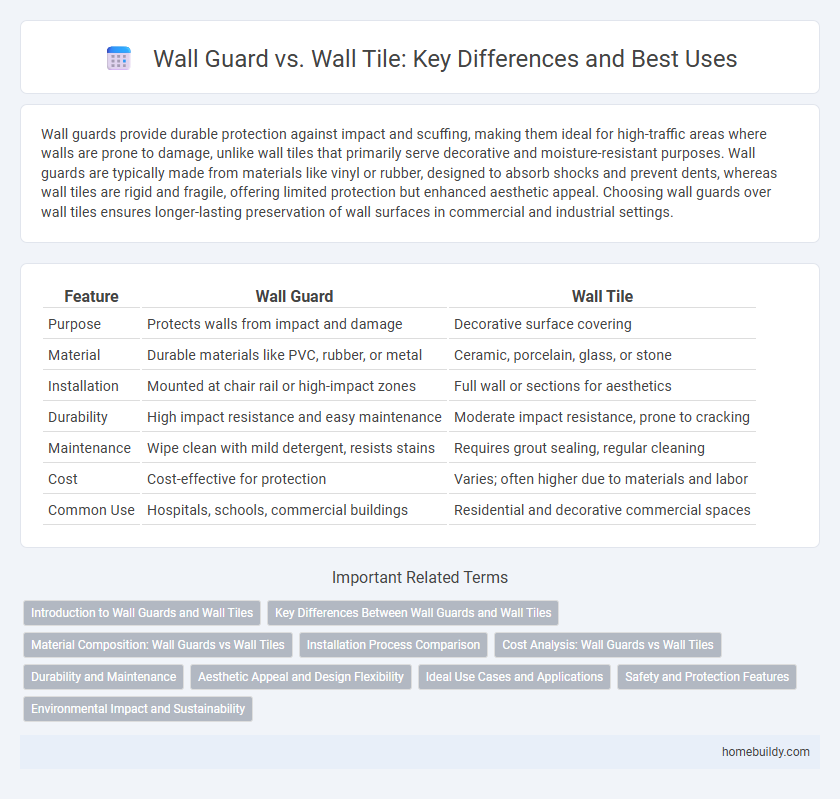Wall guards provide durable protection against impact and scuffing, making them ideal for high-traffic areas where walls are prone to damage, unlike wall tiles that primarily serve decorative and moisture-resistant purposes. Wall guards are typically made from materials like vinyl or rubber, designed to absorb shocks and prevent dents, whereas wall tiles are rigid and fragile, offering limited protection but enhanced aesthetic appeal. Choosing wall guards over wall tiles ensures longer-lasting preservation of wall surfaces in commercial and industrial settings.
Table of Comparison
| Feature | Wall Guard | Wall Tile |
|---|---|---|
| Purpose | Protects walls from impact and damage | Decorative surface covering |
| Material | Durable materials like PVC, rubber, or metal | Ceramic, porcelain, glass, or stone |
| Installation | Mounted at chair rail or high-impact zones | Full wall or sections for aesthetics |
| Durability | High impact resistance and easy maintenance | Moderate impact resistance, prone to cracking |
| Maintenance | Wipe clean with mild detergent, resists stains | Requires grout sealing, regular cleaning |
| Cost | Cost-effective for protection | Varies; often higher due to materials and labor |
| Common Use | Hospitals, schools, commercial buildings | Residential and decorative commercial spaces |
Introduction to Wall Guards and Wall Tiles
Wall guards are protective strips installed on walls to prevent damage from impacts and abrasion, commonly used in high-traffic areas such as hospitals and commercial buildings. Wall tiles, typically made of ceramic or porcelain, serve both decorative and functional purposes by providing a durable, easy-to-clean surface that enhances wall aesthetics. While wall tiles focus on surface protection and design, wall guards specifically absorb physical impacts, making them essential for wall preservation in busy environments.
Key Differences Between Wall Guards and Wall Tiles
Wall guards are protective installations designed to prevent damage to walls in high-traffic areas, typically made from durable materials like rubber, stainless steel, or vinyl, whereas wall tiles primarily serve decorative and aesthetic purposes, offering a variety of textures, colors, and patterns. Wall guards provide impact resistance and ease of maintenance, making them ideal for commercial spaces, while wall tiles focus on enhancing interior design with water-resistant and stain-resistant properties suitable for kitchens and bathrooms. The key differences lie in functionality, material composition, and application environments, where wall guards prioritize protection and durability and wall tiles emphasize style and surface finish.
Material Composition: Wall Guards vs Wall Tiles
Wall guards are typically made from impact-resistant materials such as vinyl, rubber, or stainless steel, designed to protect surfaces from damage in high-traffic areas. Wall tiles, often constructed from ceramic, porcelain, or natural stone, prioritize aesthetic appeal and water resistance rather than durability against physical impact. The material composition of wall guards emphasizes strength and flexibility, whereas wall tiles focus on hardness and decorative finish.
Installation Process Comparison
Wall guards are typically easier and quicker to install than wall tiles, often requiring adhesives or screws directly onto clean, smooth surfaces without complex grout work. Wall tile installation demands precise alignment, surface preparation, adhesive application, and grout filling, making the process more labor-intensive and time-consuming. For high-traffic areas needing rapid protection and minimal downtime, wall guards provide a more efficient installation solution compared to wall tiles.
Cost Analysis: Wall Guards vs Wall Tiles
Wall guards generally offer a more cost-effective solution compared to wall tiles, as they require less material and labor for installation and maintenance. Wall tiles often involve higher upfront expenses due to the cost of individual tiles and the specialized labor needed for precise placement and grouting. Over time, wall guards provide durable protection against damage in high-traffic areas, reducing repair costs and extending wall lifespan.
Durability and Maintenance
Wall guards offer superior durability compared to wall tiles, as they are designed to withstand impacts, scratches, and heavy wear in high-traffic areas. Maintenance of wall guards is simpler, requiring only regular cleaning with mild detergents, whereas wall tiles often demand grout upkeep and occasional repairs due to cracking or chipping. This makes wall guards an ideal choice for environments prioritizing long-lasting protection and low-maintenance requirements.
Aesthetic Appeal and Design Flexibility
Wall guards offer enhanced design flexibility with customizable shapes, colors, and materials that seamlessly blend functionality and aesthetics, unlike traditional wall tiles which often come in standard sizes and patterns. Wall guards provide a sleek, modern appearance that complements contemporary interiors while protecting walls from damage, making them ideal for high-traffic areas. Their ability to integrate with various design themes offers a more personalized aesthetic appeal compared to the uniform look of ceramic or porcelain tiles.
Ideal Use Cases and Applications
Wall guards provide durable protection for high-traffic areas such as hospitals, schools, and commercial kitchens, preventing damage from carts, wheelchairs, and equipment. Wall tiles offer aesthetic versatility and easy maintenance, making them ideal for residential bathrooms, kitchens, and decorative wall surfaces. Choosing between wall guards and wall tiles depends on the need for impact resistance versus design flexibility in specific environments.
Safety and Protection Features
Wall guards provide superior impact resistance and protect walls from damage caused by carts, wheelchairs, and other equipment, making them ideal for high-traffic areas. Unlike wall tiles, which primarily serve decorative purposes and can crack or chip under stress, wall guards are designed with durable materials such as vinyl or rubber to absorb shocks and prevent dents or holes. Their non-slip and antibacterial surfaces also enhance safety and hygiene, contributing to a safer environment in hospitals and commercial settings.
Environmental Impact and Sustainability
Wall guards offer a more sustainable alternative to traditional wall tiles by reducing maintenance frequency and material waste due to their durability and easy repair. Manufactured often from recycled or eco-friendly materials like PVC or rubber, wall guards contribute to lower environmental impact compared to the energy-intensive production of ceramic or porcelain wall tiles. Their reusability and resistance to damage extend product lifespan, enhancing resource efficiency and promoting green building practices.
Wall guard vs Wall tile Infographic

 homebuildy.com
homebuildy.com